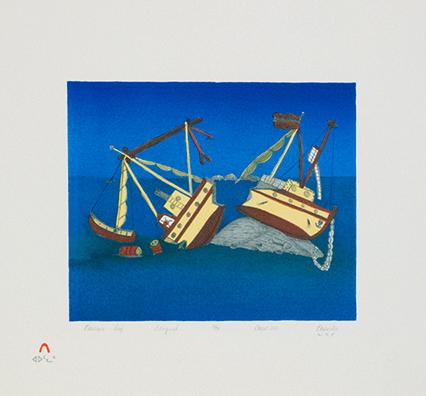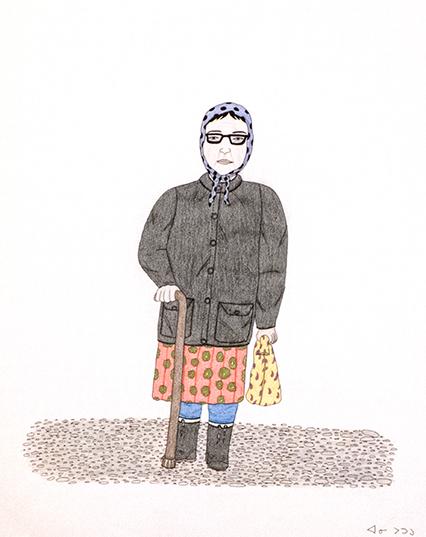‘Akunnittinni’ Brings Works of Three Generations of Inuit Artists to the National Museum of the American Indian in New York
The Inuit women whose work is chronicled in “Akunnittinni: A Kinngait Family Portrait” are known for illustrating life’s intimacies within their Arctic communities and families, as well as life’s challenges. “Akunnittinni,” an Inuktitut word that loosely translates to “between us,” describes the visual conversation struck by the artworks of Pitseolak Ashoona (1904–83), Napachie Pootoogook (1938–2002) and Annie Pootoogook (1969–2016). Grandmother, mother and daughter each produced an oeuvre reflective of village life, rich with celebration and joy, but also sometimes taking a critical eye to the role of modernity and its effects on Inuit culture.
“Akunnittinni: A Kinngait Family Portrait” features 18 total works, six from each artist, and opens Saturday, June 10, at the Smithsonian’s National Museum of the American Indian, George Gustav Heye Center in New York. The exhibition, on view in the center’s second-floor corridor gallery, runs through Jan. 8, 2018.
For the most part, the family’s practice is inspired from their community, Kinngait, located on Dorset Island in Nunavut, Canada. Artists of the region are known internationally for their work, produced in places like the now famous Kinngait Studios (West Baffin Eskimo Co-operative), since the 1940s. Pitseolak Ashoona, her daughter and her granddaughter are among the most recognized.
“To me this exhibition serves as a reflection on the role of narrative between three generations of indigenous women—all from one family—which started in 1904 and ended in 2016 with the passing of Annie Pootoogook,” said Andrea R. Hanley (Navajo), exhibition curator and membership and program manager at the Institute of American Indian Arts, Museum of Contemporary Native Arts. “I was drawn to this very strong family voice within a tribal context. Coming from a matriarchal tribe myself, I feel this exhibition accurately represents contemporary indigenous feminist discourse.”
Pitseolak Ashoona
Pitseolak Ashoona was born in 1904 on Nottingham Island in Hudson Bay and grew up living in camps along the south Baffin coast. Her family life was traditional, relying on hunting and fishing for subsistence, and she learned to prepare and sew sea-mammal skin garments just as generations of Inuit women before her. Marrying young, she and her husband, Ashoona, had 17 children. Still caring for several children at the time of his death, she was faced with providing an income for her family. She moved to Cape Dorset and was encouraged to try drawing; her first stonecuts were produced in 1960. Tapping into her experiences growing up in a traditional Inuit community, she relished the opportunity to depict her memories through her art and was especially prolific. Several of her children continued in her footsteps as Cape Dorset artists, including Ottochie, Komwartok, Kaka and Kiawak Ashoona, and Napachie Pootoogook.
Napachie Pootoogook
Pitseolak Ashoona’s daughter, Napachie Pootoogook, was born at Sako, near Baffin Island. In the mid-1950s, she married sculptor and printmaker Eegyvukluk Pootoogook, with whom she had 11 children. They moved to Cape Dorset in 1965 and participated in workshops established by the West Baffin Eskimo Co-operative. From that time until almost the end of her life, Napachie Pootoogook created prints that often focused on themes of traditional home life, including darker aspects that were left out of her mother’s more idealistic representations. Her compositions include landscapes and interiors as well as narrative scenes that depict personal and ancient stories. Like her mother, she was prolific and continued to produce prints until her death in 2002.
Annie Pootoogook
Annie Pootoogook, Napachie Pootoogook’s daughter and Pitseolak Ashoona’s granddaughter, was born in 1969 in Cape Dorset. She began her art career in 1997 with the support of the West Baffin Eskimo Co-operative. Her career accelerated after her first print was released in 2003. By 2006, she had a solo exhibition at the Power Plant Contemporary Art Gallery in Toronto and won a prestigious Canadian Sobey Art Award. The inclusion of her work in the international quinquennial art exhibition “Documenta 12” in 2007 established her as a leading contemporary Inuit artist. Annie Pootoogook’s unconventional subjects challenged expectations of Inuit art. Rather than focusing on serene scenes of Arctic animals or traditional Inuit life, her images reflect her upbringing within a contemporary Canadian community experiencing transition and conflict. She later explored themes of mortality and spirituality before her untimely and tragic death in 2016.
Hanley adds, “Standing in the gallery allows the visitor to feel the conversation between these women and what was vital to them—the love, the heartache, the survival and most importantly the family.”
“Akunnittinni: A Kinngait Family Portrait” was organized by the Institute of American Indian Arts Museum of Contemporary Native Arts in Santa Fe, N.M. Extended label text is provided by Andrea R. Hanley and Edward J. Guarino.
About the National Museum of the American Indian
The National Museum of the American Indian, George Gustav Heye Center is located in the Alexander Hamilton U.S. Custom House at One Bowling Green in New York City. For additional information, including hours and directions, visit AmericanIndian.si.edu. Follow the museum via social media on Facebook, Twitter and Instagram. Join the conversation using #Akunnittinni.
About the Institute of American Indian Arts
For more than 50 years, the Institute of American Indian Arts (IAIA) has played a key role in the direction and shape of Native expression. With an internationally acclaimed college, museum and tribal support resource through the IAIA Land Grant Programs, IAIA is dedicated to the study and advancement of Native arts and cultures—and committed to student achievement and the preservation and progress of their communities. Learn more about IAIA and its mission at www.iaia.edu.
About IAIA Museum of Contemporary Native Arts
The mission of the IAIA Museum of Contemporary Native Arts (MoCNA) is to advance contemporary Native art through exhibitions, collections, public programs and scholarship. MoCNA's outreach through local and national collaborations allows it to continue to present the most progressive Native arts and public programming. MoCNA's exhibitions and programs continue the narrative of contemporary Native arts and cultures.
# # #
SI-289A-2017




